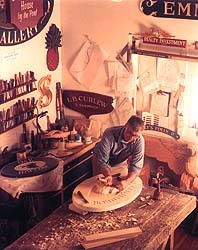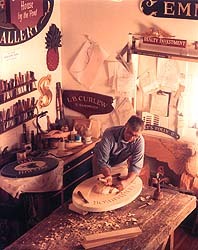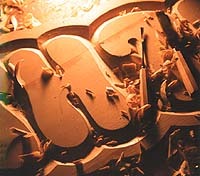Ask 10 grandmothers how to make an apple pie. Chances are, you’ll come back with 10 different, but equally tasty recipes. The same rule applies in sign-making. Ask a group of sign-makers what the best brand of lettering quill is; ask them how to lay goldleaf; or ask them how to pinstripe.
For each question, you’ll receive a myriad of replies. Does that mean some of the sign-makers you’ve polled are incompetent? Absolutely not. In sign-making, as in life, people practice what they’ve been preached; they do what they’ve been taught to do. And, if what they’ve been taught works, how can it be wrong?
This is also true when it comes to letter-carving. Depending on whether you attend Jay Cook’s (Stowe Sign Co.) carving classes in Stowe, VT; Dusty Yaxley’s (Letter Art) carving sessions in New Port Richey, FL; or Paul White’s (Paul White Woodcarving) carving school in E. Sandwich, MA, you’ll learn a different carving method. Cook focuses on carving with chisels, while self-taught Yaxley prefers to carve with V-tools. Meanwhile, White’s method is heavily influenced by his wood-sculpting background.
Yet neither Cook, Yaxley nor White’s method is incorrect. All three are extremely effective and yield attractive dimensional signs. In fact, White says that he occasionally has students in his carving course who have already taken Cook’s class. To such students, White recommends they practice his carving method exclusively while they’re learning with him.
Then, when the students begin carving on their own, White suggests they meld both carving methods into a system that best suits their needs. Tool chest When speaking to White about carving, I asked him what tools he recommends. His response was hesitant: He doesn’t like to recommend particular products.
Like carving techniques, tool-brand preferences are highly individualized, he explains. So instead, he simply suggests that carvers choose tools made of high-quality, properly tempered steel. ("Tempering" is the process by which the steel is heated, shaped and cooled. And a "quality" tool is one that holds its cutting edge.) He said that tool brands imported from England, Switzerland and Japan are favorites among many carvers, although he uses a set of custom tools.
Advertisement
However, White does recommend that beginners not purchase a set of pre-packaged carving tools; if they do, they’ll end up with more tools than they’ll ever need or use. Instead, he suggests these carving staples: Three straight chisels. Specifically, a 1/2- or 5/8-inch chisel, a 1-inch chisel and a 1 1/2-inch chisel. (Note: Imported carving tools are usually listed in metric units.) Two Number-3 gouges, one of which is 3/8 inch wide, one of which measures 3/4 inch wide. One small- to medium-sized V-tool. One fishtail chisel.
Just what are these tools and how are they used? Before describing their differences, it’s probably best to describe their similarities. All of these tools comprise a sharpened steel blade on a handle. And, assuming you’re using the tools at the prerequisite 45-degree angle to the wood surface, all are effective carving implements. In fact, in the hands of a skilled sign-maker, any type of chisel or V-tool can be used in most any carving situation.
Now for the differences. Chisels: A straight chisel is a rectangular steel blade with a handle. Because a chisel’s blade gets sharpened from both sides, a straight chisel doesn’t dig into wood. You’re probably more familiar with a knife, which is essentially a modified chisel. However, a knife has one corner of its rectangular blade cut off on a 45-degree angle. Another difference is that a carver pulls a knife toward himself, while a straight chisel gets pushed away.
Hence, different muscle groups are used for the two processes. Also, a knife doesn’t work as well as a chisel does on harder wood. Why use a chisel? A chisel can be used to "slice" wood. "Slicing" wood differs from "pushing" wood in that the process is methodical, controlled and rhythmic; consider how you slice bread, for example.
Gouges: A gouge is a curved chisel. In other words, it’s a chisel that’s shaped like a scoop. The degree to which a gouge blade is scooped is called its "sweep." A Number-3 gouge has a very slight scoop (like the edge of a circle), while a Number-11 gouge blade has a more severe curve.
V-tools: A V-tool comprises two chisels welded together. As its name implies, it looks like a "V" from the end. Because of its V shape, the blade is difficult to sharpen properly. A great utility tool, a V-tool is effective for grooving, and can be used to carve most any letter shape — except periods. Also, when you carve with a V-tool, one of its blades rips the wood, while the other one cuts; hence, this implement works particularly well in hard woods.
Advertisement
Fishtail chisels: Like the V-tool, the fishtail chisel is named for its appearance. Because a fishtail chisel’s blade flares out, it can be used to carve in tight places — periods, flourishes and the like. Again, these tools comprise a great starter set for the beginning carver. But, if you can get by with fewer implements, that’s great too.
White says it’s the finished, carved sign that counts — not how you created the sign. "If you can carve adequately with a razor blade between your toes, why would you want to buy a set of chisels?," he asks. Can anyone learn to carve? White says that in 32 years of carving, he’s not met anyone who hasn’t been able to do so…with practice, of course. Sharpening a chisel properly is actually more difficult than carving with one. "Carving is like driving a car," he says. "At first, you have to concentrate on the clutch and the brake. Eventually, though, you can do it without even thinking."


 Photo Gallery7 days ago
Photo Gallery7 days ago
 Ask Signs of the Times1 week ago
Ask Signs of the Times1 week ago
 Paula Fargo4 days ago
Paula Fargo4 days ago
 Real Deal1 day ago
Real Deal1 day ago
 Benchmarks2 weeks ago
Benchmarks2 weeks ago
 Photo Gallery4 days ago
Photo Gallery4 days ago
 Women in Signs1 week ago
Women in Signs1 week ago
 Women in Signs1 week ago
Women in Signs1 week ago

















